Bulletin – June 2019 Australian Economy Competition and Profit Margins in the Retail Trade Sector
- Download 419KB

Abstract
Net profit margins have declined for both food and non-food retailers over recent years. This has been driven by a decline in gross margins suggesting a reduction in firms' pricing power. This is consistent with information from the Reserve Bank's business liaison program about heightened competition in the retail trade sector. Liaison indicates that firms are seeking to offset the decline in margins through measures such as vertically integrating supply chains and adjusting product mixes. Retailers also report a push to reduce operating expenses such as rent and labour, though with mixed success.
Introduction
A consistent theme in discussion with firms in the Reserve Bank's business liaison program for several years has been heightened competition in the retail trade sector.[1] The retail sector has undergone significant structural change since the early 2000s, including the rise of online shopping and the entrance of new international firms into the market. Firms suggest these changes have increased competitive pressures and that, in response, they have had to adjust their pricing behaviour to compete for sales and market share. While firms in other industries also report changes in the level of competition over time due to similar factors, liaison has identified the retail sector as being particularly affected. Survey-based measures also suggest that business conditions in the retail sector have been weaker than other industries in recent years (Graph 1).
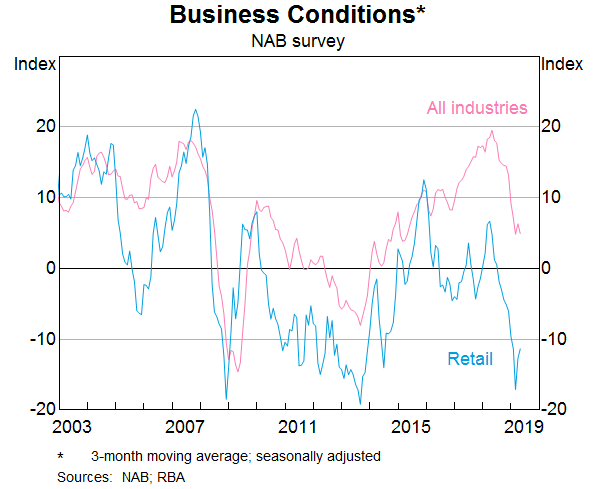
Firms suggest that consumers in the retail sector are increasingly price sensitive and that, in response, they have had to adjust their pricing behaviour, typically by increasing the size or ‘depth’ of discounts on their products, as well as the frequency. Retail goods, such as furniture, food, clothing and footwear, comprise around one-third of the Australian Consumer Price Index. This increase in discounting behaviour by retailers has been one of the factors contributing to low inflation outcomes in the Australian economy in recent years (Debelle 2018).
This price competition may also affect the profit margins of retailers as they seek to maintain a ‘lowest price position’ in the market. This could, in turn, influence other business decisions and have wider economic consequences. For example, firms may decide to defer or cancel investment plans, or they may reduce the number of staff they employ or the number of hours their staff work. Some firms are even willing to forego profits to gain market share by ‘loss leading’ or selling products at a loss; this is likely to increase the risk that firms become unprofitable. This could have implications for the asset quality of banks if firms are unable to repay their debt obligations, though the flow-on effect to Australian banks so far appears minimal (Araujo and de Atholia 2018).[2]
This article explores recent dynamics in retail firms' pricing behaviour and their impact on profit margins. It draws on information from firms in the Bank's business liaison program, as well as data from the Australian Bureau of Statistics (ABS).
Price-setting Behaviour of Retailers
Firms often attribute the increase in competition to the actions of a perceived ‘market leader’ that is looking to expand their market share by lowering prices (Ballantyne and Langcake 2016). In response, other retailers are forced to adjust their own pricing behaviour to compete for sales. While there is an increasing availability of detailed micro-level datasets to investigate the price-setting processes of individual firms, the use of qualitative information from surveys can also provide useful insights into how individual firm characteristics affect pricing decisions (Fabiani et al 2005). Firms in the Bank's business liaison program are periodically surveyed about their price-setting behaviour, including how frequently they review and change their prices, and what factors influence these decisions (Park, Rayner and D'Arcy 2010). These responses can also be compared over time to see whether firms' price-setting behaviour has changed.
Around 60 per cent of retailers in the Bank's liaison program indicate that they currently review their prices either daily or weekly (Graph 2). The data also suggest that the frequency of price reviews has increased over time, which is likely to reflect advances in technology that have reduced information costs for both consumers and firms (Debelle 2018). Consumers are able to easily compare the price of products across multiple firms and determine which is offering the lowest price. Firms are able to continually monitor the online prices of other retailers using web scraping tools to ensure their products are competitively priced, and to adapt quickly to changes in the retail environment. The data from the Bank's liaison program also indicate that the frequency of price reviews is positively related to the perceived level of competition; of the firms that review prices on a daily or weekly basis, almost all characterised the level of competition in their market as ‘significant’.
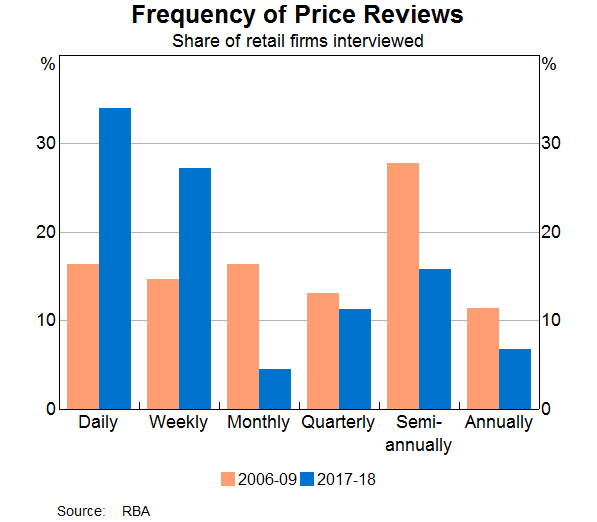
An advantage of survey-based pricing studies is that they allow us to identify the factors that have caused a firm to change their prices. In regular interviews, retailers are asked to assess the importance of five factors on their decision to change prices over the preceding 12 months by ranking them on a scale of ‘unimportant’ (a score of 1) to ‘very important’ (a score of 4). An increase in costs is the most significant factor in a firm's decision to increase prices, while a decrease in demand or a change in a competitor's prices are the significant factors in a firm's decision to lower their prices (Graph 3).[3] When compared over time, these factors have become more significant in retailers' decisions to decrease prices. This may indicate competitive pressures have intensified and are having more influence on the price-setting behaviour of retailers.
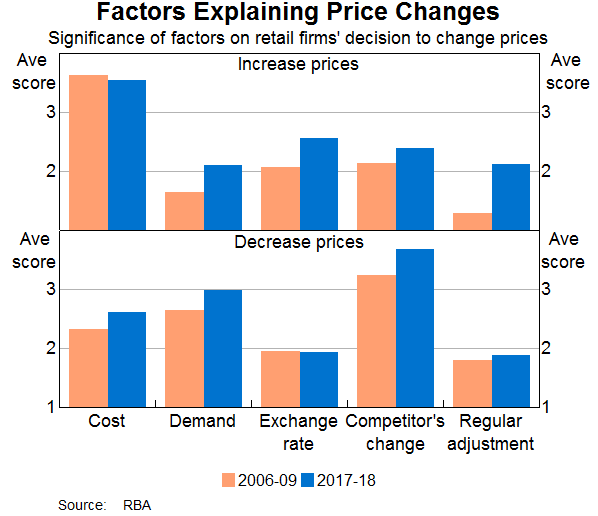
The Impact of Competition on Firms' Margins
To understand the role of margins in price setting, it is useful to work with a stylised version of the retail supply chain (D'Arcy, Norman and Shan 2012). Goods are manufactured either domestically or overseas and sold to a wholesaler, who then on-sells them to a retailer. The price paid by the retailer, along with any freight costs, comprises the retailers' ‘cost of goods sold’ (COGS). To cover these costs the retailer applies a gross margin or ‘mark-up’ to obtain the final sale price charged to consumers. The retailer also incurs expenses in its day-to-day operations, such as labour and rent, as well as marketing, packaging and administration. These operating expenses are collectively referred to as the ‘cost of doing business’ (CODB). The difference between the CODB and the retailers' gross margin is their profit or ‘net margin’.
While liaison with firms suggests that competitive pressures in the retail sector have increased over recent years and that firms have had to adjust their pricing behaviour in response, competition is not directly observable. Instead, we must rely on proxy measures such as firm-level ‘mark-ups’. Hambur and La Cava (2018) estimated retail mark-ups by measuring the ratio of price to marginal cost. They found mark-ups rose over the mid 2000s but have declined in recent years, which suggests the retail sector has become more competitive.
In this article, we infer the effect of competition by constructing a series of net and gross margins for Australian retail firms using the ABS ‘Australian Industry’ series, which is produced annually using data sourced from the Economic Activity Survey conducted by the ABS and Business Activity Statements provided by almost every Australian business to the Australian Tax Office. We analyse margins at the two-digit Australian and New Zealand Standard Industrial Classification level, and disaggregate the retail sector into the categories ‘food’ and ‘non-food’ to separately analyse the effect of competition across both.
Net margins
We find that net margins have declined for both food and non-food retailers over recent years (Graph 4). This is consistent with information from liaison of heightened competition. Net margins for food retailers (such as supermarkets and grocery stores) have declined by around 1¾ percentage points since 2011/12. This has occurred alongside the expansion of foreign supermarkets into the Australian market as well as a period of aggressive price competition between the major domestic supermarkets. Net margins for non-food retailers have declined by a similar amount. This finding is in line with other research: for example, Hambur and La Cava (2018) found that firm-level ‘mark-ups’ had declined since 2012, while Ballantyne and Langcake (2016) concluded that the relatively high level of the Australian dollar between 2010 and 2013 had led to increased competition from foreign online retailers.
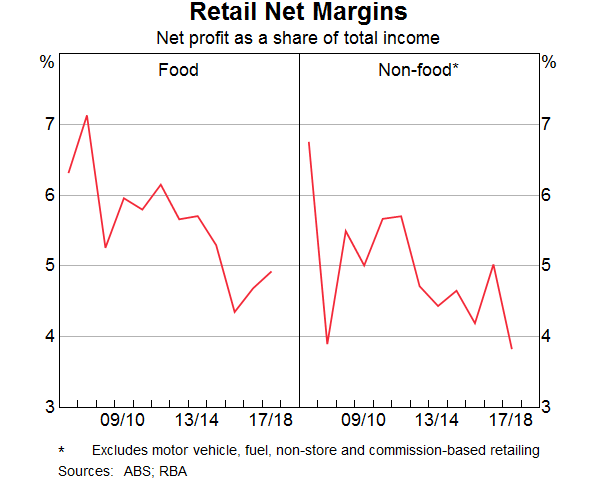
Gross margins
While the decline in retail net margins is consistent with heightened competition, a decline in net margins can be caused by one of two things: a reduction in gross margins (due to lower prices or higher COGS) or because firms' operating expenses, such as labour and rent, are increasing and they are unable to pass them through to final prices. We find that the decline in net margins for both food and non-food retailers has been driven by a decline in gross margins (Graph 5). The decline in gross margins is particularly marked for non-food retailers, falling by around 6 percentage points since 2011/12, indicating a reduction in their pricing power.
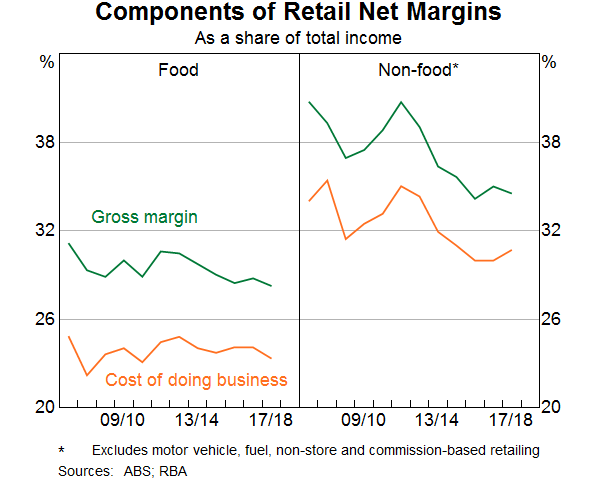
However, a consistent theme in liaison with both food and non-food retailers over the past couple of years has been a focus on firms trying to rebuild their gross margins by adjusting their business practices, including through measures such as:
- Adjusting product mixes to incorporate more own brand or private label products. These products are designed and manufactured by the retailers themselves, which reduces third-party costs. Own brand products also allow the retailer to differentiate their product offering from that of their competitors, affording them a degree of pricing power. Some retailers are also incorporating more premium brands into their product mix that are of a higher quality and attract a higher price and margin.
- Improved inventory management and stock monitoring practices have reduced the need to discount as aggressively to clear excess stock, particularly for seasonal products such as summer apparel. Some retailers report this has also been achieved by rationalising their product range and reducing the number of individual products or ‘stock keeping units’ they sell.
- Non-food retail firms are increasingly moving to an ‘everyday low price’ (EDLP) strategy, where the prices of key products have been lowered permanently. This differs from the traditional ‘high-low’ pricing strategy which uses a cycle of discounts and promotional sales. While EDLP strategies have been used by supermarkets for a few years, they are becoming more common among discount department stores, as well as specialty apparel and homewares retailers, that have a high degree of product homogeneity. By offering a consistent and predictable low price, retailers are able to attract a constant flow of foot traffic through stores and increase their sales volumes. This growth in sales volumes enhances the firm's bargaining power with wholesalers, allowing them to negotiate a lower average unit cost on products.[4]
- Vertically integrating supply chains to increase productivity. This occurs when a retailer owns or controls each step along their supply chain, removing third-party intermediaries and reducing costs. A number of firms report that they now purchase products directly from manufacturers rather than through a wholesaler, allowing them to reduce their COGS and capture wholesalers' margins. Some firms have also transitioned from using manufacturers in China to lower-cost countries in South-East Asia such as Bangladesh, India, Thailand and Vietnam (Graph 6).
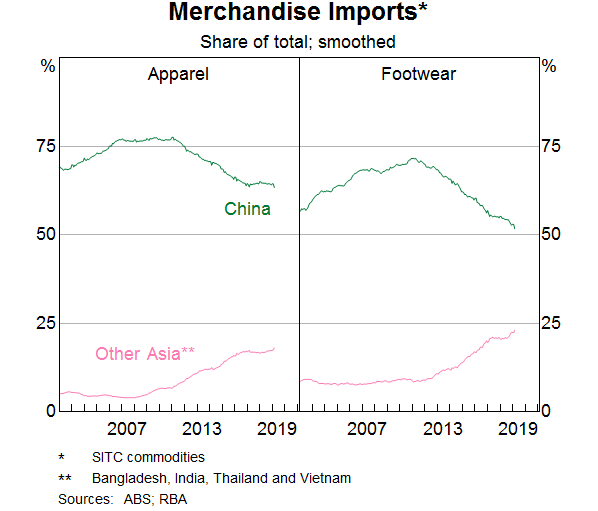
The ‘cost of doing business’
The decline in gross margins has been partially offset by a reduction in firms' operating expenses. Firms often report an inability to pass cost increases through to final prices due to competitive pressures and are, instead, absorbing them into their net margins. To mitigate this, there has been a strong push by firms to reduce their CODB. The Australian Industry data disaggregate CODB broadly into ‘labour expenses’ (which includes wages and salaries, as well as other associated costs such as employer contributions to superannuation and payroll tax) and ‘other expenses’ (which captures expenditure on items such as rent, marketing and advertising).
We find that non-food retailers have had considerable success in lowering their CODB over recent years by reducing their ‘other expenses’ (Graph 7). While food retailers appear to have had less success in reducing their expenditure, it is worth noting they have a lower cost base to begin with. Rent is typically the second largest operating expense for a retailer and firms have been able to lower this by closing underperforming stores or by reducing the size of their physical ‘bricks and mortar’ stores and expanding their online presence.[5] Firms have also been able to negotiate lower rent increases with landlords. Given softer retail trading conditions, increased supply of retail space and the rise of online shopping, some landlords have been willing to offer lower rent increases or incentives such as rent-free periods to secure low-risk, long-term tenants that attract foot traffic through shopping centres (Araujo and de Atholia 2018). Firms have also been able to reduce expenditure on ‘discretionary’ items, such as advertising and marketing, by using more digital and social media. These are not only cheaper than traditional mediums such as TV commercials or catalogues, but reach a wider audience and can also be targeted to specific consumer demographics.
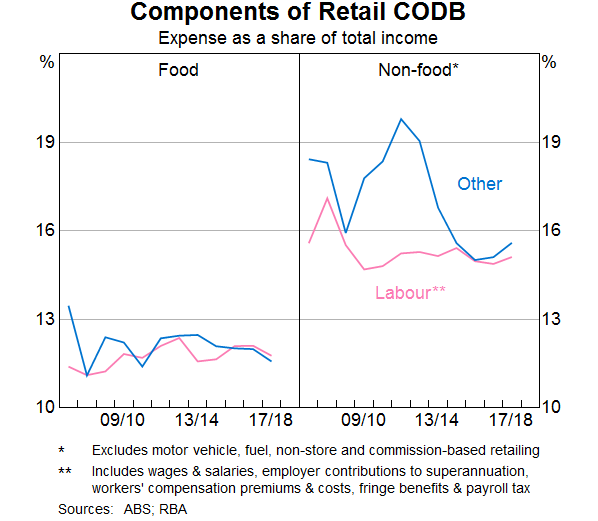
Wages are typically the largest expense for a retailer and firms appear to have been able to control growth in their labour expenses in recent years. This has partly been achieved by reducing headcount, including by introducing self-service checkouts and consolidating back-office support roles. However, firms note that they have also been responding to increases in competition by enhancing the ‘in-store experience’ by improving the level of customer service and increasing the range of services offered. Retailers are unwilling to reduce headcount too much due to the negative impact it may have on service and sales.
Firms have also been able to control growth in labour expenses through more efficient rostering. A number of firms report investing in computerised rostering systems and using data analytics to track intraday sales patterns, allowing them to optimise staff numbers and minimise overtime and penalty payments. This has been complemented by an increased use of part-time labour to provide greater flexibility with rostering decisions (Graph 8).
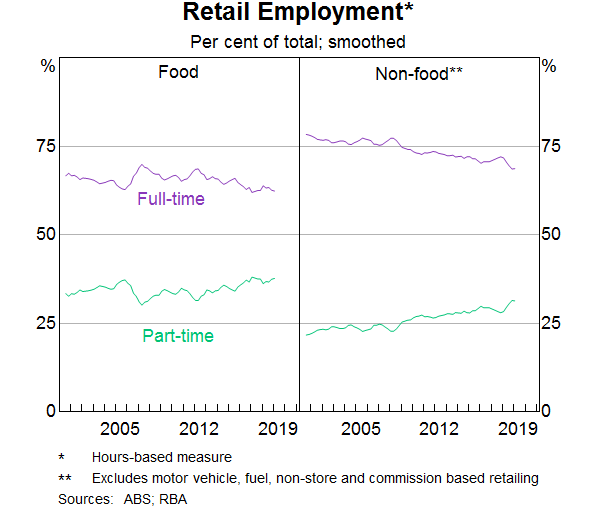
Conclusion
We find evidence to suggest that competition in the retail sector has increased in recent years, which supports messages from firms in the Bank's business liaison program and previous analytical work. Net margins have declined for both food and non-food retailers reflecting a reduction in firms' pricing power as they compete for sales and market share. Using survey-based results, we also find that competition is an important determinant in the price-setting behaviour of retailers, influencing the frequency of price reviews and the willingness of firms to lower the prices of their products. Firms have responded to these challenges by changing their business models to increase their pricing power and gross margins, through measures such as vertically integrating supply chains, or by transitioning to ‘everyday low price’ strategies. Liaison also indicates that firms have managed to partly offset the decline in margins through a focus on reducing operating expenses such as rent and labour, though with mixed success.
Footnotes
The author is from Economic Analysis Department and would like to thank Tom Rosewall for his comments and feedback. [*]
The Reserve Bank's business liaison team conducts around 70–80 discussions each month with firms, agencies and community groups. Liaison meetings are held nationally with firms of all sizes, though most discussions are with mid-sized and large firms where conditions are somewhat more likely to reflect economy-wide trends rather than firm-specific factors. For more information, see RBA (2014). [1]
Araujo and de Atholia (2018) find that the major banks' non-performing loan ratios for the retail business sector remain low and that banks' exposures to retail businesses are declining. [2]
These findings are in line with other international surveys. For example Greenslade and Parker (2010) found the same pattern of causal factors for the UK as Graph 3 shows for Australia. [3]
Firms often highlight the ‘virtuous circle’ of EDLP: lowering unit costs allows them to lower final prices further, which leads to an increase in foot traffic and sales volumes, further enhancing their bargaining power with wholesalers to negotiate even lower unit costs. [4]
The inability for food retailers to lower ‘other’ expenses may also reflect that the rise in online retail has largely been concentrated in the non-food sector. [5]
References
Araujo G and T de Atholia (2018), ‘Financial Stability Risks and Retailing’, RBA Bulletin, September, viewed 22 May 2019.
Ballantyne A and S Langcake (2016), ‘Why Has Retail Inflation Been So Low?’, RBA Bulletin, June, pp 9–18.
D'Arcy P, D Norman and S Shan (2012), ‘Costs and Margins in the Retail Supply Chain’, RBA Bulletin, June.
Debelle G (2018), ‘Low Inflation’, Speech at the Economic Society of Australia (QLD) Business Lunch, Brisbane, 22 August.
Fabiani S, M Druant, I Hernando, C Kwapil, B Landau, C Loupias, F Martins, TY Mathä, R Sabbatini, H Stahl and Ad CJ Stokman (2005), ‘The Pricing Behaviour of Firms in the Euro Area’, ECB Working Paper Series No 535.
Greenslade J and M Parker (2010), ‘New Insights into Price-setting Behaviour in the United Kingdom’, Bank of England Working Paper No 395.
Hambur J and G La Cava (2018), ‘Business Concentration and Mark-ups in the Retail Trade Sector’, RBA Bulletin, December, viewed 22 May 2019.
Park A, V Rayner and P D'Arcy (2010), ‘Price-setting Behaviour – Insights from Australian Firms’, RBA Bulletin, June, pp 7–14.
RBA (Reserve Bank of Australia) (2014), ‘The RBA's Business Liaison Program’, RBA Bulletin, September, pp 1–5.